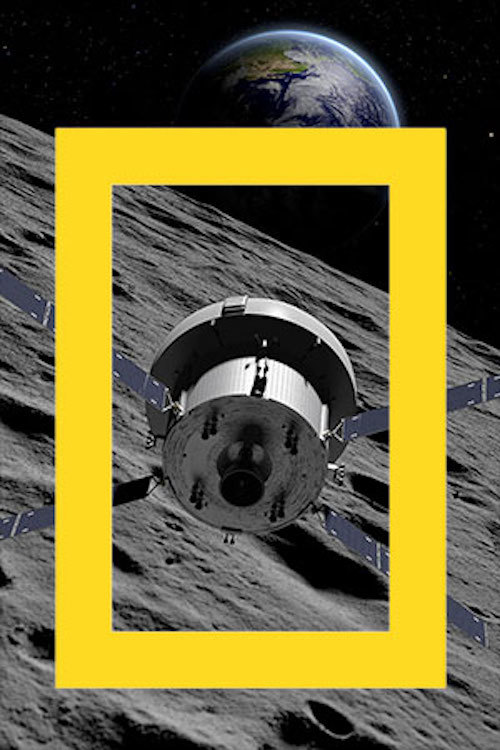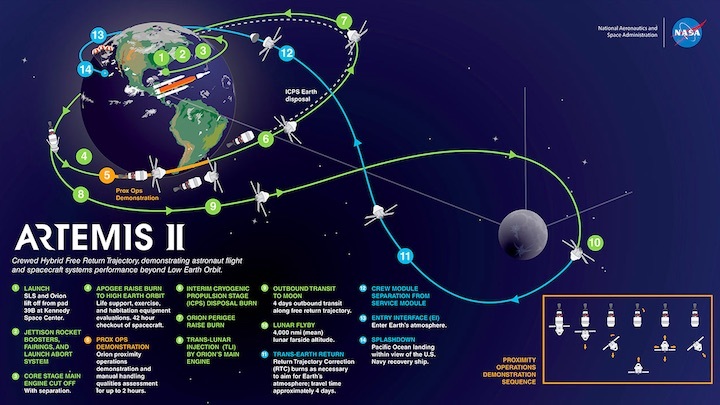1.11.2021

NASA and National Geographic are partnering to visually document the Artemis II mission. (NASA/National Geographic/collectSPACE)
When NASA next returns astronauts to the moon, National Geographic cameras will be on board to capture the historic mission and share the journey with the public.
The space agency on Friday (Oct. 29) announced its selection of the exploration-focused media company to assist in telling the story of Artemis II, the first mission expected to launch astronauts around the moon in more than 50 years.
"This time, we are bringing partners and technologies that will create additional opportunities for the world to share in the experience along with our astronauts," Kathy Lueders, NASA's associate administrator for space operations, said in a statement.
Under the terms of a non-reimbursable (no-exchange-of-funds) Space Act Agreement, National Geographic will collaborate with NASA on flying compact, lightweight audiovisual hardware inside the Orion spacecraft that will carry four astronauts on a 10-day mission into deep space. National Geographic, which is partly owned by The Walt Disney Company, plans to use its portfolio of media assets — including magazines, digital content and television programming — to engage audiences around the world.
Artemis II will be the first crewed and second lunar mission conducted under NASA's Artemis program, which has the overall goal of establishing a sustained presence on the moon to ultimately support sending humans to Mars. Artemis I, scheduled for February 2022, will debut the Space Launch System architecture needed for such missions on an uncrewed flight around the moon.
Artemis III will land the first astronauts on the moon since the Apollo program ended in the early 1970s. National Geographic's presence on Artemis II will help NASA convey its reasons for returning to and exploring the moon.
The crew of Artemis II has yet to be named, but will come out of a group of 18 men and women that NASA selected as its "Artemis Team" in December 2020. One of the crew members will be a Canadian astronaut, though, per the terms of an agreement between the Canadian Space Agency and NASA.
The agreement with National Geographic follows a competitive selection process that began with NASA soliciting proposals in November 2020.
"We're looking for partners to use advanced technologies, imagery applications and approaches that will go beyond our standard coverage on NASA TV," then-NASA Administrator Jim Bridenstine said. "We want to capture the awe of Apollo for a new generation — the Artemis Generation. Just as people were glued to the TV 50 years ago as astronauts took the first steps on the moon, we want to bring people along in this new era of exploration."
In its solicitation, NASA sought ideas that would augment its own cameras, which will be aboard Orion to provide technical and operational support. The agency's list of examples included "360-degree field-of-view camera systems; virtual reality; advanced imagery compression to improve image quality over limited bandwidth communication links; unique storytelling and distribution methods; 4K and Ultra HD camera systems; robotic 'third-person' views; crew handheld camera systems; image stabilization; small portable cameras; or other concepts that provide more engaging imagery or deliver a custom viewer experience."
National Geographic said its capabilities would include "creating an immersive experience aboard Orion to share the story of human exploration of the moon."
The new Artemis II collaboration builds upon but is separate from an earlier announced partnership between National Geographic and NASA, which set the framework for a multiyear series documenting the agency's "Return to the Moon." That project intends to track the Artemis program "right up to the moment" NASA lands the Artemis III crew at the lunar south pole.
"For more than 130 years, National Geographic has created a legacy of bringing landmark stories and achievements to world audiences," Courteney Monroe, president of National Geographic global television networks, said in December 2020. "With extensive access to this history-making mission, we can once again inspire the world with a story of courage, imagination, passion and self-sacrifice through the eyes and the hearts of the Artemis team."

NASA graphic showing the notional plan for the Artemis II mission, the first to return humans to lunar orbit. (NASA)
Quelle: CS
